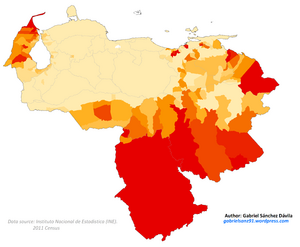Indigenous peoples in Venezuela facts for kids
Indigenous people in Venezuela, also called Native Venezuelans, are the first people who lived in the land now known as Venezuela. They make up about 2% of Venezuela's total population. However, many Venezuelans have some indigenous family history.
Most indigenous people live in the southern Amazonas state, where they are nearly half of the population. They also live in the Andes mountains in the western state of Zulia. The largest group is the Wayuu, with about 200,000 people. They mainly live in Zulia, near Lake Maracaibo and the border with Colombia. Other groups live in the less populated southeastern states like Amazonas, Bolívar, and Delta Amacuro.
Venezuela has at least 30 different indigenous groups. Some of the largest include the Wayuu (around 413,000 people), Warao people (36,000), Ya̧nomamö (35,000), Kali'na (34,000), Pemon (30,000), Anu͂ (21,000), and Huottüja (15,000). Other groups are the Motilone Barí, Ye'kuana, and Yaruro.
Contents
History of Indigenous Peoples in Venezuela
Life Before European Arrival
We don't know exactly how many people lived in Venezuela before the Spanish arrived. It might have been around one million people. These groups grew maize (corn) in the west and manioc (cassava) in the east. They used methods like slash and burn farming to grow crops.
Indigenous peoples in Venezuela already knew about crude oil and asphalt that came up from the ground. They called this thick, black liquid mene. They used it for medicine, light, and to seal their canoes.
Spanish Arrival and Resistance
Spain began to colonize mainland Venezuela in 1522. They built their first lasting settlement in the city of Cumaná. The name "Venezuela" is said to come from palafito villages (houses on stilts) on Lake Maracaibo. These villages reminded Amerigo Vespucci of Venice, Italy, so he called it "little Venice."
Indigenous caciques (leaders) like Guaicaipuro (born around 1530) and Tamanaco (died 1573) tried to fight against the Spanish. However, the Spanish eventually took control. Many indigenous people died after the Spanish arrived, mostly from new diseases from Europe. Some resisting tribes and leaders are remembered in place names today, like Caracas and Los Teques.
Early Spanish settlements were mainly on the northern coast. But in the mid-1700s, the Spanish moved further inland along the Orinoco River. Here, the Ye'kuana people strongly resisted in 1775 and 1776.
Later Challenges and Changes
After the Spanish period, governments in the 1800s did little to help indigenous peoples. They were often pushed away from the main farming areas to the edges of the country.
In 1913, during a time when rubber was very valuable, a leader named Colonel Tomas Funes took control of San Fernando de Atabapo in Amazonas. Over the next nine years, Funes destroyed many Ye'kuana villages and killed thousands of Ye'kuana people.
In 1999, the Pemon people protested by destroying some electricity towers. These towers were built to carry power from the Guri Dam to Brazil. The Pemon argued that cheap electricity would encourage more mining companies to come, which could harm their lands. The project was finished in 2001.
Political Organization of Indigenous Peoples
The National Council of Venezuelan Indians (Consejo Nacional Indio de Venezuela, CONIVE) was created in 1989. It represents most indigenous peoples in Venezuela. It has 60 groups connected to it, representing 30 different peoples.
In September 1999, indigenous peoples marched to the National Congress in Caracas. They wanted the new constitution to include important rights for them. These rights included owning their land, being able to cross international borders freely, choosing their nationality, and having their land boundaries clearly marked.
Legal Rights for Indigenous Peoples
Before Venezuela's 1999 constitution, the legal rights for indigenous peoples were falling behind other countries in Latin America. Many other countries were already adding collective rights for indigenous groups into their laws. The 1961 constitution had actually reduced some rights from the 1947 constitution.
The 1999 constitution process created "the region's most progressive indigenous rights system." This new constitution included important new rules. For example, Article 125 guarantees that indigenous people can have political representatives at all levels of government. Article 124 stops companies from getting patents (special rights) for indigenous genetic resources or knowledge.
Venezuela's new constitution also set aside special seats in the National Assembly for indigenous representatives (three seats). It was the first Latin American constitution to also set aside indigenous seats in state assemblies and local councils in areas with indigenous populations.
Languages Spoken by Indigenous Peoples
The main language families spoken by indigenous peoples in Venezuela are:
- Arawakan languages
- Carib languages
- Chibchan languages
See also
 In Spanish: Pueblos indígenas de Venezuela para niños
In Spanish: Pueblos indígenas de Venezuela para niños
- Panare people
Images for kids
-
A palafito (house on stilts) in the Orinoco Delta.
-
Mucuchí women, who were part of the larger Timoto–Cuica people.




